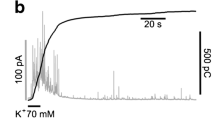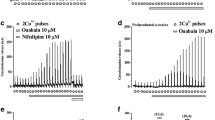Abstract
Zn2+ increased the rate of spontaneous release of catecholamines from bovine adrenal glands. This effect was Ca2+ independent; in fact, in the absence of extracellular Ca2+, the secretory effects of Zn2+ were enhanced. At low concentrations (3–10 μM), Zn2+ enhanced the secretory responses to 10-s pulses of 100 μM 1,1-dimethyl-4-phenylpiperazinium (DMPP, a nicotinic receptor agonist) or 100 mM K+. In the presence of DMPP, secretion was increased 47% above controls and in high-K+ solutions, secretion increased 54% above control. These low concentrations of Zn2+ did not facilitate the whole-cell Ca2+ (I Ca) or Ba2+ (I Ba) currents in patch-clamped chromaffin cells. Higher Zn2+ concentrations inhibited the currents (IC50 values, 346 μM for I Ca and 91 μM for I Ba) and blocked DMPP- and K+-evoked secretion (IC50 values, 141 and 250 μM, respectively). Zn2+ permeated the Ca2+ channels of bovine chromaffin cells, although at a much slower rate than other divalent cations. Peak currents at 10 mM Ba2+, Ca2+, Sr2+ and Zn2+ were 991, 734, 330 and 7.4 pA, respectively. Zn2+ entry was also evidenced using the fluorescent Ca2+ probe fura-2. This was possible because Zn2+ causes an increase in fura-2 fluorescence at the isosbestic wavelength for Ca2+, i.e. 360 nm. There was a slow resting entry of Zn2+ which was accelerated by stimulation with DMPP or high-K+ solution. The entry of Zn2+ was concentration dependent, slightly antagonized by 1 mM Ca2+ and completely blocked by 5 mM Ni2+. The entry of Ca2+ evoked by depolarization with high-K+ solution was antagonized by Zn2+. We conclude that inhibition by Zn2+ of evoked catecholamine secretion is associated with blockade of Ca2+ entry through Ca2+ channels recruited by DMPP or K+. However, the facilitation of secretion observed at low Zn2+ concentrations, or in the absence of Ca2+, may be exerted at an intracellular site on the secretory machinery. This is plausible because Zn2+ permeates the bovine chromaffin cell Ca2+ channels and in this way gains access to the cytosol. In addition, we have established conditions for measuring Zn2+ transients in fura-2-loaded cells with a very high sensitivity, taking advantage of the high-affinity binding of Zn2+ to fura-2 and the modification of its fluorescence spectrum.
Similar content being viewed by others
References
Albillos A, García AG, Gandía L (1993) ω-Agatoxin-IVA-sensitive calcium channels in bovine chromaffin cells. FEBS Lett 336:259–262
Alonso MT, Sánchez A, García-Sancho J (1990) Arachidonic acid-induced calcium influx in human platelets. Comparison with the effects of thrombin. Biochem J 272:435–443
Bettger WJ, O'Dell BL (1981) A critical role of zinc in the structure and function of biomembranes. Life Sci 28:1425–1438
Bulbena O, Esplugues JV, Escolar G, Gil L, Navarro C, Esplugues J (1990) Zinc acexamate inhibit gastric acid and pepsinogen secretion in the rat. J Pharm Pharmacol 42:252–256
Busselberg D, Evans ML, Rahmann H, Carpenter DO (1991) Lead and zinc block a voltage-activated calcium channel of Aplysia neurons. J Neurophysiol 65:786–795
Busselberg D, Michael D, Evans ML, Carpenter DO, Haas HL (1992) Zinc (Zn2+) blocks voltage gated calcium channels in cultured rat dorsal root ganglion cells. Brain Res 593:77–81
Carbone E, Sher E, Clementi F (1990) Ca currents in human neuroblastoma IMR32 cells: kinetics, permeability and pharmacology. Pflügers Arch 416:170–179
Csermely P, Szamel M, Resch K, Somogyi J (1988) Zinc can increase the activity of protein kinase C and contributes to its binding to plasma membranes in T lymphocytes. J Biol Chem 263:6487–6490
Dreosti LE (1989) Neurobiology of zinc. In: Mils CF (ed). Zinc in human biology. Springer, Berlin Heidelberg New York, pp. 235–247
Fenwick EM, Marty A, Neher E (1982) Sodium and calcium channels in bovine chromaffin cells. J Physiol (Lond) 331:599–635
Frederickson CJ (1989) Neurobiology of zinc and zinc-containing neurons. Int Rev Neurobiol 31:145–238
Frederickson CJ, Pérez Clausell J, Danscher G (1987) Zinc containing ZS-NGF complex. Evidence from zinc histochemistry for local action in salivary secretory granules. J Histochem Cytochem 35:579–583
Gandía L, López MG, Fonteríz RI, Artalejo CR, García AG (1987) Relative sensitivities of chromaffin cell calcium channels to organic and inorganic calcium antagonists. Neurosci Lett 77:333–338
Grynkiewicz G, Poenie M, Tsien RY (1985) A new generation of Ca2+ indicators with greatly improved fluorescence properties. J Biol Chem 260:3440–3450
Hamill OP, Marty A, Neher E, Sakmann B, Sigworth FJ (1981) Improved patch-clamp techniques for high-resolution current recording from cells and cell-free membrane patches. Pflügers Arch 391:85–100
Hechtenberg S, Beyersmann D (1993) Differential control of free calcium and free zinc levels in isolated bovine liver nuclei. Biochem J 289:757–760
Kawa K (1979) Zinc-dependent action potentials in giant neurons of the snail Euhadra quaestia. J Membr Biol 49:325–344
Knight DE, Baker PF (1983) The phorbol ester TPA increases the affinity of exocytosis for calcium in “leaky” adrenal medullary cells. FEBS Lett 160:98–100
Moro MA, López MG, Gandía L, Michelena P, García AG (1990) Separation and culture of living adrenaline- and nor-adrenaline-containing cells from bovine adrenal medullae. Anal Biochem 185:243–248
Peters S, Koh J, Choi DW (1987) Zinc selectively blocks the action of N-methyl-D-aspartate on cortical neurons. Science 236:589–593
Prasad AS (1979) Clinical, biochemical and pharmacological role of zinc. Annu Rev Pharmacol Toxicol. 19:393–426
Shellenberger MK, Gordon JH (1971) A simplified procedure for simultaneous assay of norepinephrine, dopamine and 5-hydroxytryptamine from discrete brain areas. Anal Biochem 39:356–372
Shukla R, Wakade AR (1991) Functional aspects of calcium channels of splanchnic neurons and chromaffin cells of the rat adrenal medulla. J Neurochem 56:753–758
Slomianka L (1992) Neurons of origin of zinc-containing pathways and the distribution of zinc-containing boutons in the hippocampal region of the rat. Neuroscience 48:325–352
Tomsig JL, Suszkiw JB (1993) Intracellular mechanism of Pb2+-induced norepinphrine release from bovine chromaffin cells. Am J Physiol 265:C1630-C1636
Wensink J, Molenaar AJ, Woroniecka UD, Hamer CJA (1988) Zinc uptake into synaptosomes. J Neurochem 50:782–789
Winegar BD, Lansman JB (1990) Voltage-dependent block by zinc of single calcium channels in mouse myotubes. J Physiol (Lond) 425:563–578
Xie X, Smart TG (1991) A physiological role for endogenous zinc in rat hippocampal synaptic neurotransmission. Nature 349:521–524
Xie X, Smart TG (1993) Giant GABAB-mediated synaptic potentials induced by zinc in the rat hippocampus: paradoxical effects of zinc on the GABAB receptor. Eur J Neurosci 5:430–436
Author information
Authors and Affiliations
Rights and permissions
About this article
Cite this article
Vega, M.T., Villalobos, C., Garrido, B. et al. Permeation by zinc of bovine chromaffin cell calcium channels: relevance to secretion. Pflugers Arch. 429, 231–239 (1994). https://doi.org/10.1007/BF00374317
Received:
Revised:
Accepted:
Issue Date:
DOI: https://doi.org/10.1007/BF00374317




